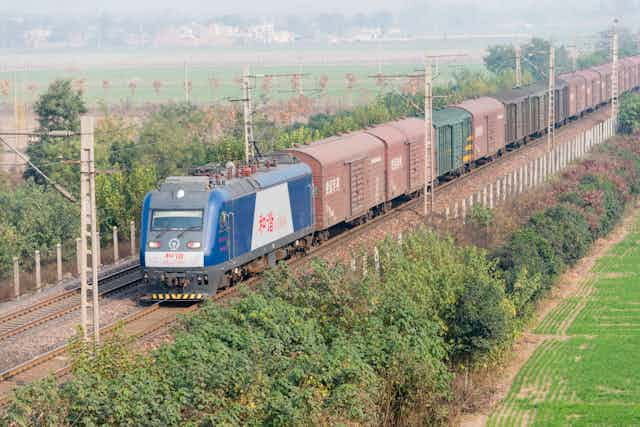The first freight train from China to the UK has started its 12,000 mile journey from the industrial city of Yiwu in the east of China to London. Part of China’s “One Belt, One Road” project to link east and west, it is all geared toward strengthening its global influence.
London is the final stop on a long and complex network of trade routes that China has forged in recent years. Central Asia – along similar lines of the old Silk Road trading route – has been the main focus of infrastructure development. But China is also intent on developing its trade and investment ties with Europe. With 39 routes linking 16 Chinese cities to 15 European ones, it includes a rail network that cuts across Central Asia to Iran, through Turkey to Russia, Poland and Spain.
After adopting the mantle of the “workshop of the world”, China shifted from rejecting US-led capitalism to fully embracing it. Its new Silk Road trade routes now serve to export many of its goods, but are also used to bring meats from Germany, wine from France and wood from Russia back in return.
But the routes serve more than just trade. They are embedded in China’s strategy of building an international Asian society and its concerted geopolitical push across the whole of continental Asia.
Taking a lead in Asia
China is getting more assertive. Its growing economic and military presence around the South China Sea show it is intent on building for itself a robust sphere of influence, based on interlinking economic and military relationships.
So the new One Belt, One Road project sits alongside the Shanghai Cooperation Organisation, a major regional security organisation, and the building of relations with countries around the Indian Ocean. Meanwhile, China is also working toward signing a large free trade agreement with the Association of South-East Asian countries, Australia, India, Japan, Republic of Korea and New Zealand.
The project is the focus for China’s westward strategy and foreign direct investment. It provides a vehicle for the mobilisation of Chinese businesses throughout Asia. In 2015, 44% of China’s engineering projects outside of China were in countries along the new Silk Road, rising to more than 52% in 2016. With US$4 trillion behind the project, this is soft power on a massive scale. Asian rival India is, of course, wary of China’s growing influence on its doorstep – particularly the highway it has plans to build to Pakistan through the contested region of Kashmir.
Interests intertwined
Despite being the project lead – and underwriting it entirely – China is keen to present One Belt, One Road as part of its its “neighbourhood policy” of developing a favourable regional environment. Chinese leaders maintain that they are pursuing common goals across the region, with no ideological aims of their own.
Instead, China’s focus is practical inter-state engagement. Investment projects use up abundant Chinese steel, concrete and other engineering products, and also use China-sourced goods and services in the interest of developing neighbouring countries, all the while encouraging enterprise in the country.
China also sees its interests and those of its neighbours as increasingly intertwined. So, across central Asia, there is a desire for investment in infrastructure, development of natural resources (starting with hydrocarbons), raising skills and employment opportunities, and of course building trade networks. For these states, inward investment not only helps enhance national security, but also improves their stability. China is not only recognising these interests but is in fact giving them a set of common platforms.

Integration through investment, construction, extraction and trade has been key for creating new orbits of economic influence. With 60 countries involved, China is working to turn Asia into a giant, interconnected entity.
Smaller regions will remain, but there now exists the real prospect of a super-Asian region emerging before the end of the 21st century. This, were it to emerge, could dwarf the European Union in scale, size and economic potential. Trade across the One Belt, One Road region is already anticipated to be more than US$2.2 trillion in ten years (catching up with the EU’s trade in goods of US$3.1 trillion).
Far-reaching consequences
The success of the initiative could have far-reaching consequences for the Asian countries involved and also the wider international order. As China pushes westwards into Asia so it will be able to exploit inner Asia’s vast natural sources and at the same time lock into its own orbit the world’s big energy zones around the Caspian sea and the Persian Gulf.
That China has embarked upon its One Belt, One Road project is a measure of its new self-confidence and a public expression of its efforts to become the heart of Asia. It dovetails with China’s strategic priorities in Asia, which combines a partnership with the Association of South-East Asian Nations (ASEAN) and the strengthening of the Shanghai Cooperation Organisation security group which it co-leads with Russia. Together, these spheres form China’s three circles of influence in Asia.
These, in different but complementary ways, contribute to China’s efforts to build security and economic bonds across its neighbourhood. The different mechanisms enhance its strategic reach as each of these circles has the basis for shaping related countries and regions. Together they multiply China’s strength and give it a credible, though perhaps not always a welcome voice, from the Pacific to the Atlantic Oceans.


